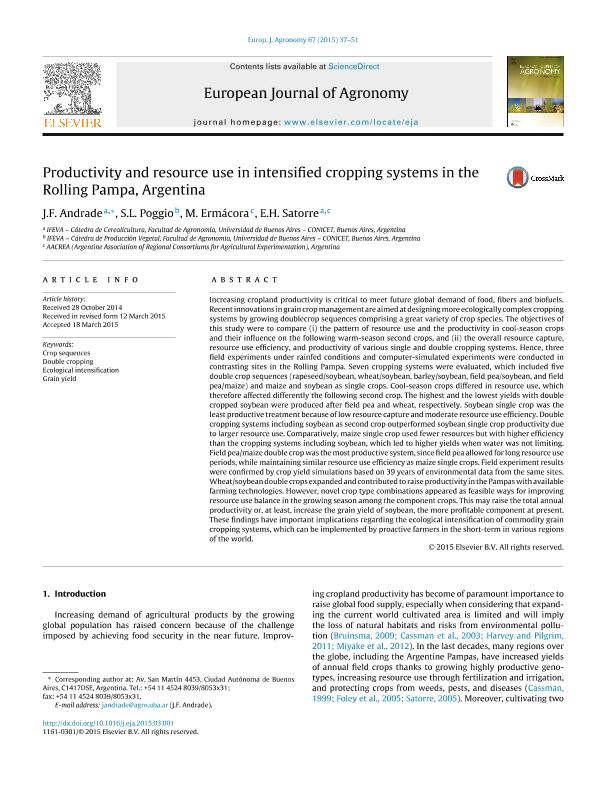Mostrar el registro sencillo del ítem
dc.contributor.author
Andrade, José Francisco

dc.contributor.author
Poggio, Santiago Luis

dc.contributor.author
Ermacora, Mario Roberto

dc.contributor.author
Satorre, Emilio Horacio

dc.date.available
2016-02-04T20:30:34Z
dc.date.issued
2015-04
dc.identifier.citation
Andrade, José Francisco; Poggio, Santiago Luis; Ermacora, Mario Roberto; Satorre, Emilio Horacio; Productivity and resource use in intensified cropping systems in the Rolling Pampa, Argentina; Elsevier; European Journal of Agronomy; 67; 4-2015; 37-51
dc.identifier.issn
1161-0301
dc.identifier.uri
http://hdl.handle.net/11336/4031
dc.description.abstract
Increasing cropland productivity is critical to meet future global demand of food, fibers and biofuels. Recent innovations in grain crop management are aimed at designing more ecologically complex cropping systems by growing double crop sequences comprising a great variety of crop species. The objectives of this study were to compare (i) the pattern of resource use and the productivity in cool-season crop sand their influence on the following warm-season second crops, and (ii) the overall resource capture, resource use efficiency, and productivity of various single and double cropping systems. Hence, three field experiments under rainfed conditions and computer-simulated experiments were conducted in contrasting sites in the Rolling Pampa. Seven cropping systems were evaluated, which included five double crop sequences (rapeseed/soybean, wheat/soybean, barley/soybean, field pea/soybean, and field pea/maize) and maize and soybean as single crops. Cool-season crops differed in resource use, which therefore affected differently the following second crop. The highest and the lowest yields with double cropped soybean were produced after field pea and wheat, respectively. Soybean single crop was the least productive treatment because of low resource capture and moderate resource use efficiency. Double cropping systems including soybean as second crop outperformed soybean single crop productivity due to larger resource use. Comparatively, maize single crop used fewer resources but with higher efficiency than the cropping systems including soybean, which led to higher yields when water was not limiting. Field pea/maize double crop was the most productive system, since field pea allowed for long resource use periods, while maintaining similar resource use efficiency as maize single crops. Field experiment results were confirmed by crop yield simulations based on 39 years of environmental data from the same sites. Wheat/soybean double crops expanded and contributed to raise productivity in the Pampas with available farming technologies. However, novel crop type combinations appeared as feasible ways for improving resource use balance in the growing season among the component crops. This may raise the total annual productivity or, at least, increase the grain yield of soybean, the more profitable component at present. These findings have important implications regarding the ecological intensification of commodity grain cropping systems, which can be implemented by proactive farmers in the short-term in various regions of the world.
dc.format
application/pdf
dc.language.iso
eng
dc.publisher
Elsevier

dc.rights
info:eu-repo/semantics/openAccess
dc.rights.uri
https://creativecommons.org/licenses/by-nc-nd/2.5/ar/
dc.subject
Crop Sequences
dc.subject
Double Cropping
dc.subject
Ecological Intensification
dc.subject
Grain Yield
dc.subject.classification
Agricultura

dc.subject.classification
Agricultura, Silvicultura y Pesca

dc.subject.classification
CIENCIAS AGRÍCOLAS

dc.title
Productivity and resource use in intensified cropping systems in the Rolling Pampa, Argentina
dc.type
info:eu-repo/semantics/article
dc.type
info:ar-repo/semantics/artículo
dc.type
info:eu-repo/semantics/publishedVersion
dc.date.updated
2016-03-30 10:35:44.97925-03
dc.journal.volume
67
dc.journal.pagination
37-51
dc.journal.pais
Países Bajos

dc.journal.ciudad
Amsterdam
dc.description.fil
Fil: Andrade, José Francisco. Consejo Nacional de Investigaciones Científicas y Técnicas. Oficina de Coordinación Administrativa Parque Centenario. Instituto de Investigaciones Fisiológicas y Ecológicas Vinculadas a la Agricultura; Argentina. Universidad de Buenos Aires. Facultad de Agronomía. Departamento de Producción Vegetal. Cátedra de Cerealicultura; Argentina
dc.description.fil
Fil: Poggio, Santiago Luis. Consejo Nacional de Investigaciones Científicas y Técnicas. Oficina de Coordinación Administrativa Parque Centenario. Instituto de Investigaciones Fisiológicas y Ecológicas Vinculadas a la Agricultura; Argentina. Universidad de Buenos Aires. Facultad de Agronomía. Departamento de Producción Vegetal; Argentina
dc.description.fil
Fil: Ermacora, Mario Roberto. Asociación Argentina de Consorcios Regionales de Experimentación Agrícola; Argentina
dc.description.fil
Fil: Satorre, Emilio Horacio. Consejo Nacional de Investigaciones Científicas y Técnicas. Oficina de Coordinación Administrativa Parque Centenario. Instituto de Investigaciones Fisiológicas y Ecológicas Vinculadas a la Agricultura; Argentina. Universidad de Buenos Aires. Facultad de Agronomía. Departamento de Producción Vegetal. Cátedra de Cerealicultura; Argentina. Asociación Argentina de Consorcios Regionales de Experimentación Agrícola; Argentina
dc.journal.title
European Journal of Agronomy

dc.relation.alternativeid
info:eu-repo/semantics/altIdentifier/url/http://www.sciencedirect.com/science/article/pii/S1161030115000362
dc.relation.alternativeid
info:eu-repo/semantics/altIdentifier/doi/http://dx.doi.org/10.1016/j.eja.2015.03.001
dc.relation.alternativeid
info:eu-repo/semantics/altIdentifier/issn/1161-0301
Archivos asociados
